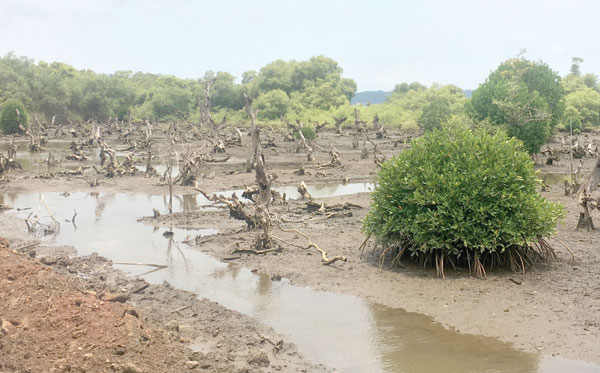05 Jun 2018 | 06:07am IST
GOAN MANGROVES...ON THE RETREAT
Nature’s natural defenders seem to be under threat from the frenzied development that has enveloped the state. Shweta Kamat takes a close look at the sad state of affairs and what needs to be done to avoid the serious problems that could result due to this destruction
Shweta Kamat
Mangroves in India have been subject to a wide variety of threats. And Goa is not an exception to it. The unregulated urban development, increased pollution, altered distribution and with increased tourism, has resulted in the most destructive impact on mangrove forests. Goa has witnessed a sharp decline of mangrove area over the last three decades- from 20,000 hectares in 1987 to 2,200 hectares in 2015.
However, despite all odds, the dedicated efforts by the forest department have given some results, with mangrove cover witnessing growth of nearly 10 sq kms over the last three years.
Mangroves are very specialized forest ecosystems of tropical and subtropical regions bordering the sheltered sea coasts and estuaries. These stabilize the shoreline and act as barriers against encroachment by the Sea. Salt tolerant inter-tidal halophytic plants dominate the mangrove forests. Mangroves are confined mainly to the narrow intertidal mudflats along the banks of Mandovi, Zuari, Chapora, Sal, Tiracol, Talpona, Galjibag and Cumbhajua canal.
The Chorao Island located in the river Mandovi is one of the best mangrove forests in Goa and houses most of the species found in Goa. Chorao mangroves have been conserved as Dr. Salim Ali Bird Sanctuary. Import species found are Rhizophora mucronata, Rhizophora apiculata, Bruguiera gymnorrhiza, Bruguiera cylindrical, Ceriops tagal, Kandelia candel (K.rheedi), Avicennia afficinalis, Avicennia marina, Avicennia alba, Sonneratia alba, Sonneratia caseolaris, Aegiceras corniculatum, Excoecaria agallocha, Acanthus illicifolius, Lumnitzera racemosa etc
Mangroves have been accorded most vulnerable status in the event of an oil spill, by the environment sensitivity index (ESI) map of Goa. There are as many as 16 identified mangrove species in Goa, which are granted protection under forest law.
“Rapidly increasing development has put numerous direct and indirect pressures on coastal ecosystems in the form of degradation and destruction. But in Goa, mangrove biodiversity, management and conservation has received considerable attention in the recent times because of the extensive degradation of mangrove areas along the entire Indian coast,” said former NIO scientist and executive secretary of Mangroves Society of India (MSI), Dr AG Untawale.
Dr Untawale, along with three other experts had conducted detail study on the mangrove cultivation of Goa. The study reveals that of Goa’s total land area of 3,70,200 ha, the mangrove area is 2,200 ha in 2015 having declined sharply from a recorded 20,000 ha in 1987.
“But the situation has changed a lot now,” he says.
The experts are of the opinion that mangrove forest or areas can be protected by extensively promoting it as a ecotourism. “In State like Goa, with an increase in tourists, the mangroves can be potentially suitable for ecotourism. It will also help in its preservation. It is possible for tourists to spend an entire day in the mangroves looking and appreciating interesting and unique plant and animals,” Dr Untawale said in his study.
He said that government on its part should effectively channel revenue generated from ecotourism activities into conservation of the mangrove swamps.
The State forest department dedicated approach towards preservation, protection and plantation has helped in the increase of mangrove cover over the years. As per the Forest Survey of India (FSI) report of 2015 and 2017, the mangrove cover in the State has increased by four sq kms and five sq kms, respectively.
“Forest cover in the state has increased by 19 sq km in recent years thanks to the increase in mangrove area by nearly 10 sq km,” a senior forest official said, while admitting that still more efforts needs to be put in place in a bid to grant more protection to these species from destruction.
Officer said that with rapid development taking place, like the National Highway expansion, bridges, and also tourism infrastructure in large scale, the department has to be more vigil to protect these plantations.
The State Government in its report ‘The Goa State Oil Spil Disaster Contingency Plan”, had spelled out that containment of oil for protection of the mangroves is the most ideal option of oil spill response. “Mangroves are most vulnerable to the oil spill. They are found along the course of Mandovi and Zuari Rivers. Along the entire stretch of Cumarjua canal which connects Mandovi and Zuari rivers, it has healthy growth. So these areas are ranked 10. East of Panjim city, several swampy lands are present which fertile grounds for mangrove vegetation are, they are also ranked 10 on the ESI scale,” the report had stated.

